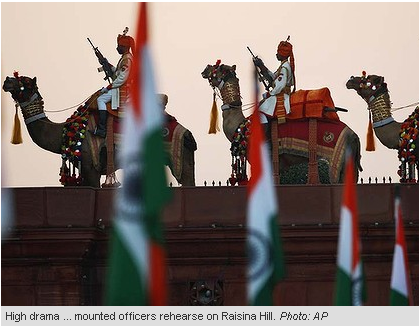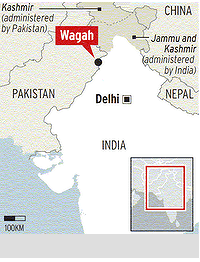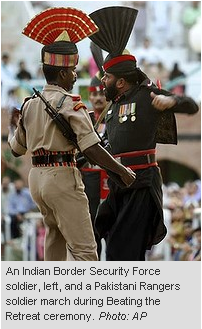Ritual dance between bitter brothers
Ben Doherty
The Sydney Morning Herald: January 29, 2012

IN THE middle of the vast green wheat fields of Pakistan's Punjab, past the smoke stacks of the brick kilns, and beyond the blast walls and barbed wire, lie the gates of the Wagah border, the only land crossing between India and Pakistan out of nearly 3000 kilometres of border.
Maddeningly slow, needlessly long, tiresome and bureaucratic, this lonely stretch of road bisecting the subcontinent's most arbitrary, troubled border, is, somehow, still the easiest way between the two countries. Flights between India and Pakistan's major cities are too infrequent and unreliable to be of great help.
I've done this crossing perhaps half a dozen times now, my passports bear testimony, littered with its funny triangular stamps.
Advertisement: Story continues below
And, despite its frustrations - which, by comparison, are really only mild - I've grown almost fond of the long dusty walk from one country to another, crossing a division that was a confection 65 years ago, but is now a cavernous divide.
grown almost fond of the long dusty walk from one country to another, crossing a division that was a confection 65 years ago, but is now a cavernous divide.
The lean man on the immigration desk on the Pakistan side remembers me now. He smokes as he languidly looks over my passport, and we chat about weather and crops and the Australian cricket team.
Usually, by the time I am heading from Pakistan to India, I can think only of home.
An Indian Border Security Force soldier, left, and a Pakistani Rangers soldier march during Beating the Retreat ceremony. Photo: AP
But this time I've lingered to see a famed, and perhaps one day, redundant spectacle I am told embodies so much of the posturing and perfidy between these two countries: the Wagah Border Retreat Ceremony.
The daily sunset ritual is a carefully choreographed piece of jingoistic theatre - barely more sophisticated than the armies of two nuclear-armed countries sulkily marking their territory, drawing a line in the sand the other daren't cross.
The crowds begin gathering in the late afternoon, and even their make-up is evidence of how far these countries have diverged since being cleaved apart barely more than two generations ago.
The Indian crowd, representatives of a country of 1.2 billion people, is, like all crowds in this country, overwhelming.
In their thousands, men and women press and push and shove unapologetically for any vantage point they can.
The crowd is populated with school groups and face-painted children and swelled by tourists in equal parts fascinated and bemused by the spectacle before them.
There are few tourists on the Pakistan side.
The crowd there is sparser; the men stand on one side of the arena, and the woman sit apart, in a separate grandstand.
Between the two groups, in the middle of the amphitheatre created by the stands, lies the border.
It is marked by two ornate gates, one reads Pakistan, the other India.
Between them is the demarcation drawn by the hastily departing British Viceroy in 1947, a man who wanted out of the country, and the problem of India out of his bailiwick.
1947, a man who wanted out of the country, and the problem of India out of his bailiwick.
As the sun sets, the chanting begins: "Pakistan Zindabad!" "Hindustan Zindabad!". Long live Pakistan, Long Live India.
The competing cacophonies ratchet up, urged on by men at microphones. As the crowd's bellicosity reaches fever pitch, out come the soldiers.
Chosen for their stature, their height is further exaggerated by enormous peacock-like fans attached to their headgear.
What follows next is 20 minutes of unadulterated chauvinism. Soldiers on both sides - the Indians in olive green, the Pakistanis in black - mimic each other in a series of war-like marches and belligerent gestures.
They high kick - the comparison with Monty Python's Ministry of Silly Walks is too apposite to be funny - while glaring furiously into each other's territory.
This is topped off with an affectatious straightening of the headgear. There is a grandiloquent handshake at one point, before a dramatic, slow, lowering of their respective flags. These are folded and run back into barracks, carefully guarded until morning when they are re-hoisted - and the border opened again for those few peripatetic souls wanting to cross from one country to the other.
This bizarre ritual in the middle of the Punjab's boundless plains is the subcontinent's Haka.
But it is a war dance that, too often in these countries' short independent histories, has seen gesture backed with deed.
India and Pakistan were carved from British India, beginning life apart at midnight on August 15, 1947. Since then they have fought three ''official'' wars, and scores of smaller skirmishes.
They are at peace now, but it is the uneasy peace of two bitter brothers, carrying too much violent history and too many unresolved feuds.
But, perhaps reflective of Indian and Pakistani government efforts to improve relations between the two countries, there are moves to tone down the theatrics and the pantomime aggression from Wagah's border ceremony.
Two years ago, the head of the Pakistan Rangers, Major General Yaqub Ali Khan said the retreat would be subdued.
"We have decided to end the angry eyeball-to-eyeball exchange, thumping of boots and other aggressive gestures from the flag-lowering parade," he said.
What difference that decision has made is not immediately apparent. The ceremony appears combative still, but locals tell me it is markedly less aggressive than it once was. And relations, even at this microcosmic level, are improving, it seems.
This day is January 26th, India's Republic Day, marking 62 years since the independent nation's constitution came into force.
To mark it, Indian soldiers give their Pakistani counterparts sweets, made with desi ghee and local fruits.
It beats making war.